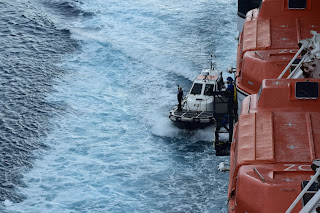Moving
swiftly Westward our next country was France and Monte Carlo. This is where the
money is. We had to take a tender in as there was not enough berth space.
Coincidentally the weather was a little rough and this slowed operations so our
time ashore was limited.
After
making our way around the harbour and its many extravagant boats…
the
beautiful façade of The Hermitage looked down on us as we walked up the hill
where, in 2008 Le Tour started with an individual time trial event (see the
2008 blog).
At
the top of the hill is the famous Hotel de Paris. Here the view is across the
many Rolls and Bentleys parked outside the Casino. There are certainly more
luxury cars per linear metre of road than any other part of the world. Being "seen" in a Ferrari just does not seem to be quite up to snuff!
I
suspect most will recognise the Monte Carlo Casino. As I use Monte Carlo
simulations a lot it was a shame there was not time for me to go inside what has precipitated a 10 year
affair.
The
following day found us in Barcelona for a two night stop. We had booked tickets
on line to overcome the queues for Sagrada Familia. Although we had been
outside the Basilica (see September 2013 blog) we had not been inside. There is still
construction work but at least there is now a target to complete by 2026 to
align with the 100 year anniversary of Gaudi’s death.
I found the outside interesting but very busy and with too much to look
at let alone comprehend. The inside however, is just stunningly beautiful. The height
and volume of the space is the first striking aspect. This was quickly
supplemented by the clean uncluttered design compared to the outside although it is
quite different to any other cathedral.
Each
column has “branches” at the top and reflects the tree design. There are burls
at the top of each trunk. In engineering terms it is unusual to see branches at
an angle and at various slopes.
The
windows along each side give marvellous light with green and blue giving a
watery feel to one side and reds, oranges and yellow on the other side
reflecting sun and sand. The light is just beautiful.
Over
the alter the Christ figure could be parachuting into the church or being
caught by an uplift on the way to heaven.
Certainly
the internal design of the tower above the crossing has a heavenly feel to it.
The
whole design really underpins the amazing imagination of Gaudi. His challenge
would have been how to describe this to those with lesser imaginations. He did this with the help of models. There are four on display that show the
migration from the rather dull pre-Gaudi design to his final basic structure.
Gaudi
realised that a catenary cable (in tension) was effectively an arch in reverse
(which is largely in compression). He produced a model with twine and small
sandbags to show the design using a myriad of catenary cables. Thanks to a
mirror (at the top) the planned “look” could be seen.
We
were joined on our tour by newlyweds Geoff (my nephew and star of the August 2012 Brugge blog) and Livia who married on the
Saturday before our departure in Sydney. By coincidence they were
honeymooning in Europe and were in Barcelona at the same time as us. A late
luncheon pint after our prolonged tour of Sagrada Familia was required.
The
following day we headed off to the Gaudi gardens. The core area which could be
accessed by all in our 20?? visit is now restricted to ticket holders only.
As they had sold out for the day we had a walk around the perimeter of the
gardens.
The
structures remain impressive
Helen
was initially very impressed by this guy’s core muscles until it was
appreciated that he was defying gravity. He may have lost his head but it was
still a pretty smart act.
At
the West end of the park is a viewing platform that Geoff and I climbed however the
girls decided they could content themselves by looking at us. (They were actually on speaking
terms but just wanted the bench to themselves.)
After
saying goodbye to G & L we left Barcelona and set off for a sea day
arriving at Ajjacio in Corsica in the evening. It is a situated in a huge
natural bay (18 X 18 kms) and at night was very picturesque.(A bit less so
during the day.)
The
town’s claim to fame is as the birthplace of Napoleon. There is a statue of him
overlooking the town with 50 steps to the top.
We
decided on a wine tour and visited two wineries. The mural at the first stop
was quite a work of art.
The
wine was not bad either despite the vats being unromantic concrete boxes lined
with epoxy paint. The barrels used for maturing some of the wine “were never
older than 4 years….” which rather flys in the face of other vineyards.
We
were fortunate to be visiting at the time of bottling some Rose. A noisy a
process with one of the team feeding empty bottles to the machine while others removed the full bottles
into a crate on a forklift at the other end.
After
the tour, suitably fortified, we headed to the town for some “L’eau avec gas”.
We sat down next to a small but aromatic market. The olives and range of
marinades provided an amazing variety of bouquets.
Which
were only surpassed by some local cheeses. They may not look too attractive but
their smell was mouth watering.
Regrettably
we then had to head back to the ship for our last night where we enjoyed the sunset with
a cocktail or two before tackling the packing.












































































